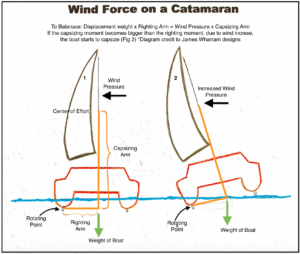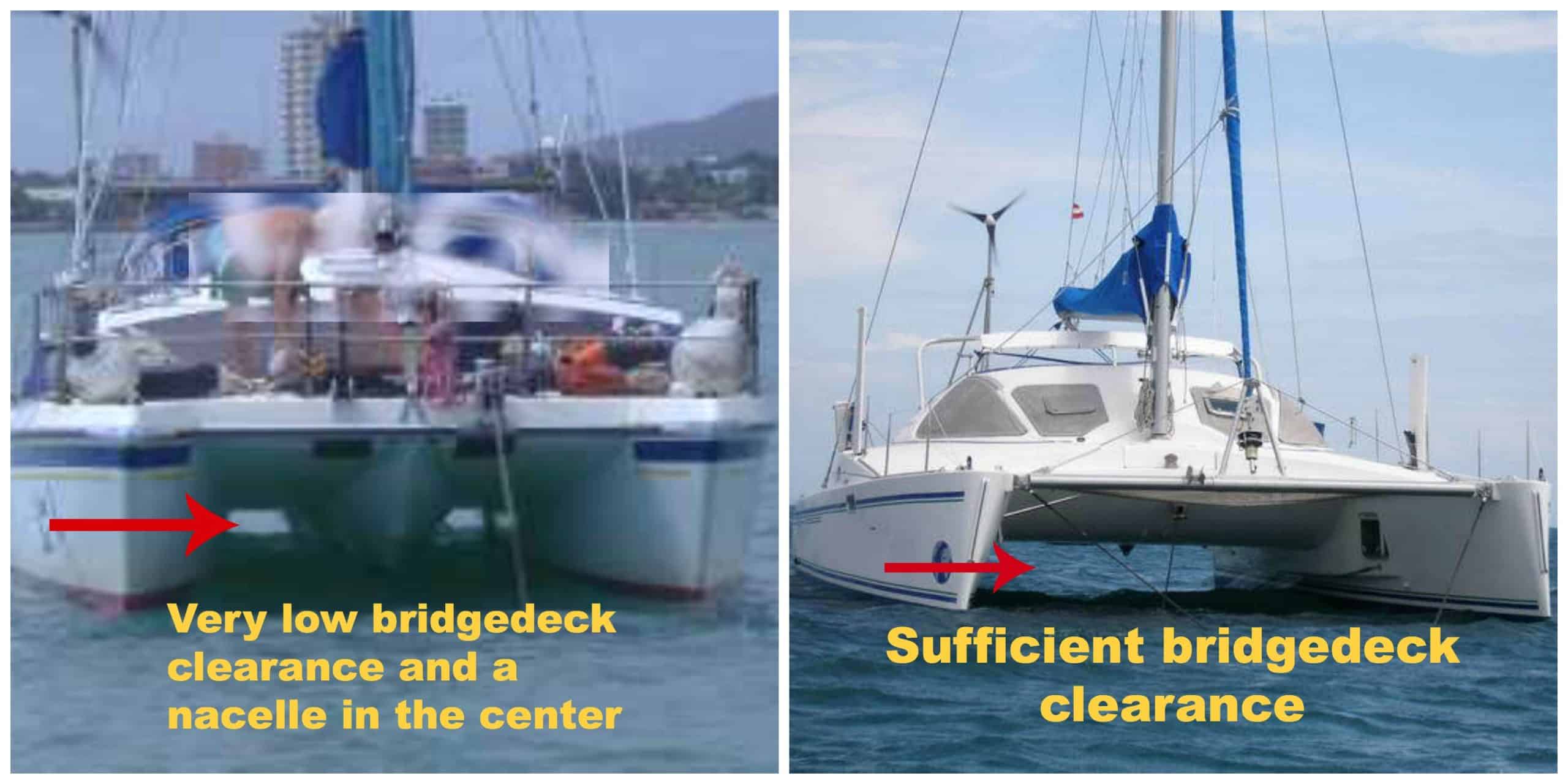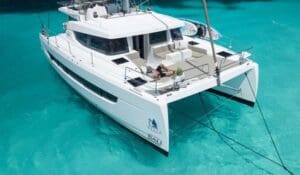What Makes a Good Catamaran?
As we (Stephen and Estelle) self-isolate during this pandemic aboard Zuri, our Bali 5.4, we thought we would share some insights about important features you should think about when buying a catamaran. We started out with 5 then at the end, Stephen threw in another 3. What are your thoughts? What are important features on a catamaran. Let us know below in the comment section.
Like all marine vessels, certain characteristics make some catamarans better than others. You will not find a perfect catamaran because no boat is perfect. Compromise is always required. But with forethought about how you will utilize your multihull, and matching your requirements to high quality design, you can get pretty close to your “dream” catamaran.
Crucial attributes to consider for a cruising catamaran are:
- Weight-carrying ability
- Bridge deck clearance
- Structural integrity and seaworthiness
- Windward ability
- Deck surface design
- Ease of handling
We will explore each of these catamaran characteristics, and how they affect performance, comfort, and, ultimately, safety.
Early catamaran designs were heavy by today’s standards. The multihulls were designed with a narrow beam, high freeboard, and inefficient underwater design. They were prone to hobby horsing and pitching. Today, with the technological advancements of lighter, stronger composite materials, catamarans performance has greatly improved.
In the last 20 years or so, boat builders have painstakingly studied and resolved the issues affecting catamarans, effectively increasing their seaworthiness by leaps and bounds. Constant reform and transformation of even the basic tenets of catamaran design continue today as is evident in the radical catamaran designs in the 2013 America’s Cup Challenge. (The foiling Gunboat G4 designs spring to mind). In fact, many of the problems of the older multihull designs have been eliminated altogether.
The new generation of cruising catamarans offers exciting, fun sailing vessels with great livability, space, comfort, and safety. This was made possible, in no small part, by the early multihull pioneers.
Catamaran Stability & Weight-Carrying Ability

WEIGHT: Unlike the monohull design that can carry weight without much loss of performance, an overloaded catamaran rapidly loses performance and, eventually, safety. In order to counter this, multihull manufacturers are continually looking for ways to reduce construction weight to increase the potential payload capacity while retaining optimal performance.To select a light catamaran, look for hulls with cored construction and interiors built with lightweight materials. Lighter construction enables catamarans to carry more weight and perform faster, so this characteristic is very important when selecting a cruising catamaran.
Monohulls can heel and spill wind when the sails are overpowered. But a catamaran’s only available response to pressure of a wind gust is to accelerate. So the boat has to be very strong to hold together. Cored construction makes the catamaran strong and very stiff. Stiffness gives a catamaran good performance.
Consider that the catamaran’s hulls are actually two boats joined together by a bridge deck. These “boats” are constantly fighting each other and trying to go in their own direction. The boat structure must be strong enough to counter this and, at the same time, deal with the downforce of the mast in the center of the bridge deck. The catamaran performs an amazing feat contending with all the opposing forces inherent in the multihull design. For that reason, it is critical to ensure the design and manufacturer are reputable with a track record to demonstrate structural integrity.
STABILITY: Unlike monohulls that rely on a heavy lead keel to keep it upright, a catamaran relies on the beam of the boat and the buoyancy of the hulls for stability. Typically cruising catamarans will have a beam to length ratio of roughly 50%. So a 45-ft long catamaran will be about 22-ft wide, providing a very stable platform. Good stability in a catamaran is when the righting forces and healing forces are in balance. So if the righting moment is greater than the capsizing moment, the boat stays upright. When the capsizing moment becomes bigger than the righting moment due to an increase in wind, the boat starts to capsize. <
This diagram and article by James Wharram, king of “self-build” catamarans, offer valuable insight into catamaran stability. Also, read this article by Shuttleworth “Design Considerations for Seaworthiness“.
Catamaran Bridge Deck Clearance
 ALL catamarans slam (waves hitting under the bridge deck). The noisy and sometimes disconcerting slamming takes getting used to. The first catamaran I ever sailed an ocean passage on was a Shuttleworth 44. In the early 90’s and even today, it is considered to be a good design. However, after a few hours of sailing in some sloppy seas off the eastern coast of Africa, the slamming noise had me convinced that the boat was going to break up and sink. Now that I have a full understanding of the nature of a catamaran, it turns out that there was no need to worry. I have come to accept that slamming is just part of sailing a catamaran. It is the degree of slamming that makes the difference between a comfortable ride and a terrifying experience.
ALL catamarans slam (waves hitting under the bridge deck). The noisy and sometimes disconcerting slamming takes getting used to. The first catamaran I ever sailed an ocean passage on was a Shuttleworth 44. In the early 90’s and even today, it is considered to be a good design. However, after a few hours of sailing in some sloppy seas off the eastern coast of Africa, the slamming noise had me convinced that the boat was going to break up and sink. Now that I have a full understanding of the nature of a catamaran, it turns out that there was no need to worry. I have come to accept that slamming is just part of sailing a catamaran. It is the degree of slamming that makes the difference between a comfortable ride and a terrifying experience.
Bridge deck clearance is a key factor in predicting the slamming level of a catamaran design. A higher clearance produces less slamming. My rule of thumb is; 4% of the overall length is low, 5% is acceptable, and 6% is good.
When it comes to slamming, another important factor is weight. If the boat is heavy due to construction or payload, it will tend to go into a wave. This slams the chest of the boat into the wave. A lighter boat with more buoyancy will rise on the wave reducing slamming substantially. “The Space Between” by Sackville Currie, explains in detail the different options, problems, and compromises.
Windward Ability: Catamaran Keels vs. Dagger Boards
 The average cruising catamaran has keels while high performance catamaran cruisers have dagger boards. Let’s look at the two schools of thought on this subject. The general perception that catamarans cannot point as high as monohulls is not entirely true. I have seen modern catamarans pointing as high as most cruising monohulls, especially in stronger winds. The issue is not how high the boat points, but rather how much leeway it makes. A monohull with a large keel (lateral resistance) makes less leeway than a catamaran with shallow keels. So, even if both vessels are pointing at 45 degrees, the monohull will be making a better track to windward.
The average cruising catamaran has keels while high performance catamaran cruisers have dagger boards. Let’s look at the two schools of thought on this subject. The general perception that catamarans cannot point as high as monohulls is not entirely true. I have seen modern catamarans pointing as high as most cruising monohulls, especially in stronger winds. The issue is not how high the boat points, but rather how much leeway it makes. A monohull with a large keel (lateral resistance) makes less leeway than a catamaran with shallow keels. So, even if both vessels are pointing at 45 degrees, the monohull will be making a better track to windward.
Catamarans with dagger boards are able to point much better than catamarans with keels. The claim is that a catamaran with dagger boards is safer because if the boards are up and the boat gets sideways on a wave, it will skid down the wave sideways. Dagger board proponents believe a keel trips the boat as it tries to navigate down the side of a wave causing capsize.
I can only speak from personal experience. I was caught sideways on a 20-foot wave a few days out of Cape Town on a 40ft catamaran with keels. The boat was hit by successive three waves before we could get it back on track. The boat skidded down the waves and there was no capsize, but it took some nifty maneuvering at the helm. My personal belief is that both types are safe and acceptable provided they are operated correctly.
Catamaran Deck Surfaces
 From a safety perspective, decks should be as wide and as flat as possible.
From a safety perspective, decks should be as wide and as flat as possible.
Cockpit to Mast
Older designs often have decks with two levels from the coach roof windows to the gunnels which form a side deck with a trip hazard. Most modern catamaran deck designs are now one flat surface being wide enough to walk unhindered from the cockpit to the mast.
Saloon
The cockpit and the saloon should be on one level with no step down into the saloon, if possible. Modern designs have achieved this and it really makes a big difference for ease of movement and safety while at sea.
Stern
The steps on the stern should be wide and easy to climb with a reasonable angle. If the steps are too steep or narrow, they become a hazard and lose space for recreation. The stern should be easily accessible from the dinghy.
Ease of Handling: Catamaran Deck Layout
 Deck layout is an important factor because most cruising catamarans are sailed short-handed. On catamarans with one helm, all lines should run back to the helm so there is a static position from where the entire boat can be controlled. I recommend electric winches and single line reefing for at least the first reef, but also the second reef, if possible. All of these of lines should come back to the static control station at the helm:
Deck layout is an important factor because most cruising catamarans are sailed short-handed. On catamarans with one helm, all lines should run back to the helm so there is a static position from where the entire boat can be controlled. I recommend electric winches and single line reefing for at least the first reef, but also the second reef, if possible. All of these of lines should come back to the static control station at the helm:
- Both jib sheets
- The sheet from the opposite side of the boat should be run through a turn block and across the coach roof through a clutch to the helm
- Main sheet
- Jib furling line
- Single line reefing lines
- Main halyard
- Outhaul
- Traveler control lines.
Visibility from the helm is also very important. All round visibility while underway, maneuvering, or docking is key to safety of your boat and others’ property and life. When standing at the helm, you should be able to see both bows or, at the very least, the pulpits. The center of the crossbeam where the anchor is handled from should be visible as well as both sterns for when you dock “stern to”. If all these stations are not visible while standing at the helm where the engine controls are, you may encounter problems because of blind spots.
Catamaran Characteristics Conclusion
Modern catamaran designs are much more advanced than the early models that were slower, heavier, and underpowered. Problems like hobby horsing, burying the bows, and underpowered rigs have been largely eliminated.
Even though composite construction technology gives a huge advantage in lighter materials and sleeker designs, no one design element or piece of high tech gear should dominate the vessel to the detriment of others. With some compromise, a good naval architect can design a vessel pleasing to most people and the result can be very exciting, safe, and seaworthy.
Top Tip: Use a Broker at No Cost
Which compromises should you make when selecting your catamaran? It all depends on how you will use her. Catamaran Guru helps new and veteran multihull owners select the right boat for their dreams at no cost! The yacht seller pays broker commissions so our advice from gleaned from thousands of boat-buying transactions is free to you. We will help you find right boat, the right program, or the right situation. If you want to explore more on your own, visit our buying a catamaran section.
Contact Us
Contact a Broker Directly





